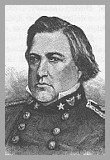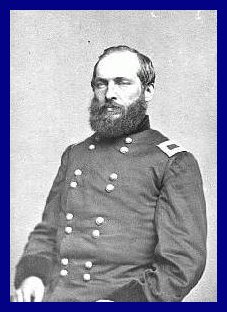The Union and Confederate forces were led by two very different men. Humphrey Marshall was a Kentucky blueblood and a representative of one of its leading families. James A. Garfield was a self-made man born in a log cabin on his father's thirty-acre Ohio farm.
A native of Cuyahoga County, Ohio, Garfield was a self-educated citizen-soldier and a self-made man. Born in poverty on his father's thirty-acre farm, he graduated from Williams College in 1856 and pursued a teaching career, becoming Professor of Latin and Greek at Hiram College in Hiram, Ohio. An ardent abolitionist, he was elected to the Ohio Senate on the Republican ticket in 1859. When the war came, Governor Dennison gave him a colonel's commission and asked him to raise a regiment of volunteers.
In December, 1861, Union General Don Carlos Buell ordered Garfield to transport his regiment, the 42nd Ohio Volunteer Infantry, to the new Union base at Catlettsburg, where he had begun stockpiling military supplies. Reporting to Buell in Louisville, Garfield was placed in charge of the newly-formed 18th Brigade and given the job of driving Marshall's Confederates out of the Big Sandy Valley. .
Following his victory at Middle Creek, which was widely reported in the Eastern press, Garfield was promoted to Brigadier General. Establishing his headquarters at Pikeville, he and his soldiers occupied the valley until early April, 1862. On March 14th, marching through deep snow, he led an expedition to Pound Gap on the Kentucky-Virginia State Line and broke up the Confederate outpost at that location, driving 300 rebel soldiers down the mountain and back into Virginia.
Marshall was the proud representative of one of Kentucky's most distinguished families. His grandfather was Humphrey Marshall, the historian and statesman, and his father was John J. Marshall of Frankfort, a highly-respected lawyer and jurist. After graduating from West Point in 1832, Marshall served with the U. S. Mounted Rangers during the Black Hawk War and then left the service to establish a successful law practice in Louisville. In the Mexican War he served as Colonel of the First Kentucky Cavalry and won distinction by leading a gallant cavalry charge during the Battle of Buena Vista.
Returning to civilian life, Marshall ran for Congress and was elected Representative of the Louisville district in 1849. He served as President Fillmore's Commissioner to China in 1852, and after his return, he was elected to the 34th and 35th Congress on the American ticket. A moderate on the slavery question, Marshall was a good orator and canvassed the state for Democratic Party presidential nominee John C. Breckenridge in 1860. Upon the secession of the southern states, he raised a large number of volunteers for the Confederate Army and was commissioned Brigadier General by President Jefferson Davis on October 30th, 1861. Establishing his headquarters at Wytheville, Virginia, Marshall was given the assignment of protecting the mountain passes on the Virginia border and gaining control of Eastern Kentucky. |




